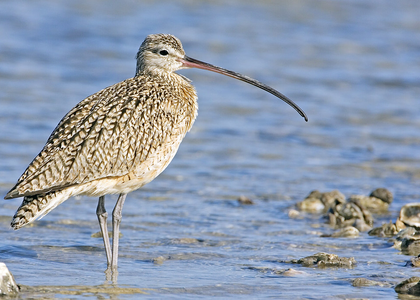Migratory bird slender-billed curlew extinct now
By IANS | Updated: October 10, 2025 21:30 IST2025-10-10T21:29:01+5:302025-10-10T21:30:19+5:30
Bonn, Oct 10 The International Union for Conservation of Nature (IUCN) on Friday declared the slender-billed curlew (Numenius ...

Migratory bird slender-billed curlew extinct now
Bonn, Oct 10 The International Union for Conservation of Nature (IUCN) on Friday declared the slender-billed curlew (Numenius tenuirostris) extinct, marking the first known global extinction of a formerly widespread migratory bird species whose range included mainland Europe, North Africa, and West Asia.
The last confirmed sighting of the species was at Merja Zerga in Morocco, just over 30 years ago, on February 25, 1995. Friday’s announcement ended hope for the survival of this species, after years of exhaustive searches for any remaining individuals.
“This devastating loss underlines the urgent and sustained need for stronger, coordinated conservation efforts for migratory birds, and migratory species in general,” the IUCN said.
Reflecting on the broader implications, Amy Fraenkel, Executive Secretary of the Convention on the Conservation of Migratory Species of Wild Animals (CMS), stated: “The extinction of the slender-billed curlew is a tragic and sobering moment for migratory bird conservation. It underscores the urgency of implementing effective conservation measures to ensure the survival of migratory species.
“Hopefully, the loss of this species will help galvanise action to protect other threatened migratory species.”
The slender-billed curlew was listed under CMS Appendix I and II at the signature of the Convention in 1979.
In September 1994, just five months before what was later confirmed as the bird’s last sighting, a memorandum of understanding concerning Conservation Measures for the Slender-billed Curlew was adopted under CMS.
The goal was to safeguard the species’ remaining individuals (then estimated at about 50) through international cooperation among 30 range states, spanning from nesting areas in northwestern Siberia and Kazakhstan to non-breeding sites in southeastern Europe, the Middle East, the Mediterranean, and North Africa.
In June 1995, a new treaty was born out of negotiations under the CMS framework to prevent the decline of the migratory waterbirds in the African-Eurasian flyway.
At the signing of the new Agreement on the Conservation of African-Eurasian Migratory Waterbirds (AEWA), the slender-billed curlew was also included as a priority species among 255 waterbird species listed for conservation.
“Two-thirds of bird species are in decline, and the slender-billed curlew’s extinction serves as a poignant reminder that conservation frameworks must be implemented swiftly, backed by adequate science, resources and sustained political will,” said Jacques Trouvilliez, the AEWA Executive Secretary.
Several other waterbird species listed under either CMS or AEWA (or both) have been moved to a higher risk level on the IUCN Red List in recent years, indicating more efforts are needed to reverse their declines.
These include waders, such as the grey plover (Pluvialis squatarola), broad-billed sandpiper (Calidris falcinellus), and curlew sandpiper (Calidris ferruginea), which were uplisted to vulnerable, and the ruddy turnstone (Arenaria interpres) and dunlin (Calidris alpina), which were uplisted to near threatened.
“With new technologies and knowledge now available, there is no excuse for allowing such tragedies to repeat. You cannot restore a species once it is gone,” says Nicola Crockford, Chair of the joint CMS/Birdlife Slender-Billed Curlew Working Group and observer for BirdLife International to AEWA and CMS.
--IANS
Disclaimer: This post has been auto-published from an agency feed without any modifications to the text and has not been reviewed by an editor
Open in app